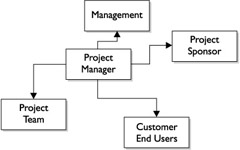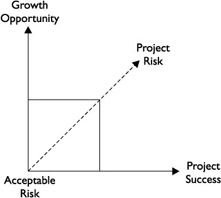Working Toward the Finish
A project requires many things: finances, hardware, time, and other resources. Chief among the required resources is a commitment from all parties involved in the project. This includes the project manager, management, the project sponsor, and the project team. You will need to create and maintain a relationship with each of these parties to ensure their continued support of the project and their commitment to seeing the project through. Project managers who isolate parties that are not actively involved with the implementation are doing their project and career a disservice. Management, project sponsors, and departments that are impacted by the technology implementation want to hear from the project manager on a regular basis, as Figure 11-6 shows. They want, and need, to be kept informed.

Figure 11-6: Project managers must keep many people informed on the project status.
Commitment from the Project Team s Managers
If you are working in a functional or matrix environment, managing a project team is a complex process that requires a commitment from the team members managers. The managers of the team members may be from several different departments within the organization, or they could all be directly within the IT department. The structure of your organization will have a huge impact on the attitude and outlook of the project team on the technology project.
For example, if all of the team members have the same manager, as is the case in a functional organization, it will be easier to coordinate activities and participation from all of the team members and the one manager. This scenario is typical in smaller companies or organizations with a very tightly structured IT department. In these instances, a relationship between you and the manager is easier to create than a project that has team members from several departments with different managers.
Typically, your project team will be comprised of team members who come from various departments and have an interest in the development and implementation of the technology. In these instances, you ll need to develop a relationship with each of the managers to relay to them what their employees are contributing to the project. A relationship is also needed so the manager can see the importance of the project and the team member s dedication to it.
Project Completion and Team Members Growth
As a project manager, your obvious goal is to complete the project as planned, on time, and on budget. As you begin to assign your team members to the tasks, you ll have a serious challenge to conquer. Team members will look to you to assign tasks that allow them to grow and learn new skills. You, on the other hand, will be looking toward the project deliverables and will want to use the resources available to get there the best and fastest way you can. The paradox is your desire to assign the strongest resources to the critical path and the desire of the team members to learn new skills and improve their abilities . This is the concept of acceptable risk in regard to team development, as Figure 11-7 demonstrates .

Figure 11-7: Team members growth must be balanced with the project s health.
The managers of the team members will want you to assign tasks to their employees fairly and according to their skill, but also allow them to stretch their abilities. The team members, using the WIIFM principle, will have a desire to complete the exciting parts of the project to gain valuable experience for their own career growth. You, of course, have a desire to complete the project smoothly and accurately from the start.
A project manager who never allows team members to attempt tasks that may be slightly beyond their grasp will not win the support of the project team. A project manager must give team members a chance to learn from the work and glean new skills and abilities. If you always assign the critical path tasks to the same technically advanced team members, they may become bored with the same type of work, just as the less technically astute team members may be bored with their perceived menial duties .
A solution that you should try to incorporate is mentoring. Allow the inexperienced (but willing to learn) team member to work with the more advanced team member on the critical path assignments. By coupling these two team members on assignments through the critical path, you are accomplishing several things:
-
Allowing the inexperienced team member to gain new experience
-
Allowing the technical team member to share his knowledge
-
Providing a degree of on-the-job training
-
Ensuring the critical path will be completed accurately
-
Satisfying the needs of management to allow team members to grow
-
Allowing your resources to become more savvy for future projects
EAN: 2147483647
Pages: 195